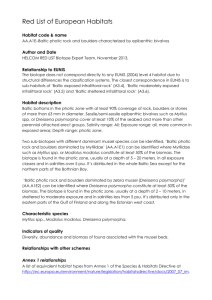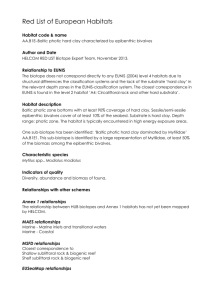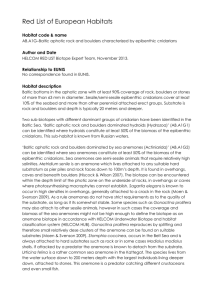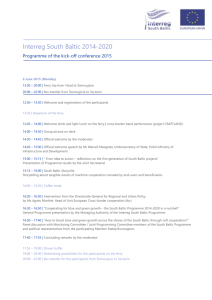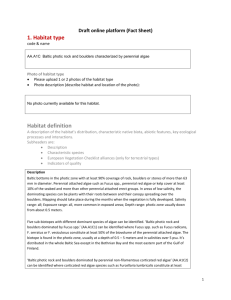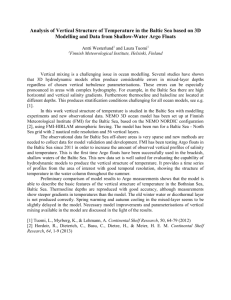Baltic AA.A1C Habitat Definition
advertisement
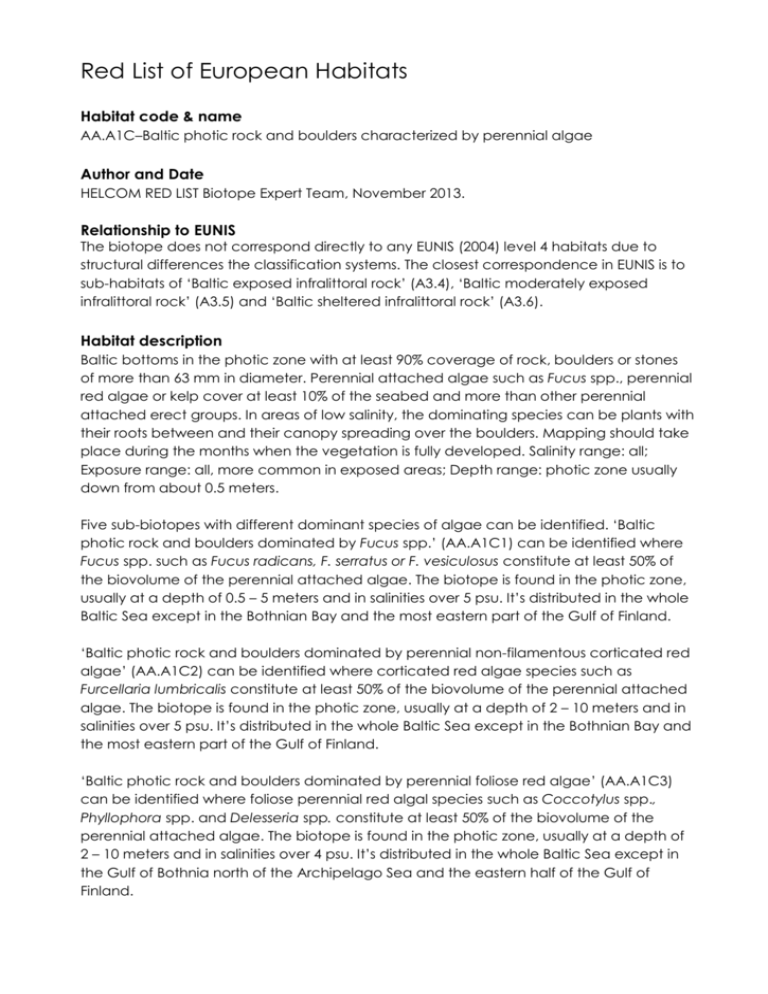
Red List of European Habitats Habitat code & name AA.A1C–Baltic photic rock and boulders characterized by perennial algae Author and Date HELCOM RED LIST Biotope Expert Team, November 2013. Relationship to EUNIS The biotope does not correspond directly to any EUNIS (2004) level 4 habitats due to structural differences the classification systems. The closest correspondence in EUNIS is to sub-habitats of ‘Baltic exposed infralittoral rock’ (A3.4), ‘Baltic moderately exposed infralittoral rock’ (A3.5) and ‘Baltic sheltered infralittoral rock’ (A3.6). Habitat description Baltic bottoms in the photic zone with at least 90% coverage of rock, boulders or stones of more than 63 mm in diameter. Perennial attached algae such as Fucus spp., perennial red algae or kelp cover at least 10% of the seabed and more than other perennial attached erect groups. In areas of low salinity, the dominating species can be plants with their roots between and their canopy spreading over the boulders. Mapping should take place during the months when the vegetation is fully developed. Salinity range: all; Exposure range: all, more common in exposed areas; Depth range: photic zone usually down from about 0.5 meters. Five sub-biotopes with different dominant species of algae can be identified. ‘Baltic photic rock and boulders dominated by Fucus spp.’ (AA.A1C1) can be identified where Fucus spp. such as Fucus radicans, F. serratus or F. vesiculosus constitute at least 50% of the biovolume of the perennial attached algae. The biotope is found in the photic zone, usually at a depth of 0.5 – 5 meters and in salinities over 5 psu. It’s distributed in the whole Baltic Sea except in the Bothnian Bay and the most eastern part of the Gulf of Finland. ‘Baltic photic rock and boulders dominated by perennial non-filamentous corticated red algae’ (AA.A1C2) can be identified where corticated red algae species such as Furcellaria lumbricalis constitute at least 50% of the biovolume of the perennial attached algae. The biotope is found in the photic zone, usually at a depth of 2 – 10 meters and in salinities over 5 psu. It’s distributed in the whole Baltic Sea except in the Bothnian Bay and the most eastern part of the Gulf of Finland. ‘Baltic photic rock and boulders dominated by perennial foliose red algae’ (AA.A1C3) can be identified where foliose perennial red algal species such as Coccotylus spp., Phyllophora spp. and Delesseria spp. constitute at least 50% of the biovolume of the perennial attached algae. The biotope is found in the photic zone, usually at a depth of 2 – 10 meters and in salinities over 4 psu. It’s distributed in the whole Baltic Sea except in the Gulf of Bothnia north of the Archipelago Sea and the eastern half of the Gulf of Finland. ‘Baltic photic rock and boulders dominated by kelp’ (AA.A1C4) can be identified where perennial attached kelp species such as Saccharina latissima and Laminaria digitata constitute at least 50% of the biovolume of the perennial attached algae. The biotope is found in the photic zone, usually at a depth of 2 – 10 meters and in salinities over 11 psu. It’s distributed only in the Sound and the Belt Sea. ‘Baltic photic rock and boulders dominated by perennial filamentous algae’ (AA.A1C5) can be identified where perennial filamentous algal species such as Polysiphonia spp, Aegagrophila linnaei, Cladophora rupestris constitute at least 50% of the biovolume of the perennial attached algae. The biotope is found in the photic zone, usually at a depth of 0.5 – 10 meters and in all salinities. It’s distributed in the whole Baltic Sea. Characteristic species Fucus spp., Furcellaria lumbricalis, Coccotylus truncatus, Phyllophora spp., Deleseria sanguinea, Saccharina latissima, Laminaria digitata , Polysiphonia spp., Cladophora rupestris, Sphacelaria spp. Indicators of quality Lower limit of vegetation, especially Fucus spp. where applicable; amount of epiphytic algae. Relationships with other schemes Annex 1 relationships The relationship between HUB biotopes and Annex 1 habitats has not yet been mapped by HELCOM. MAES relationships Marine - Marine inlets and transitional waters Marine - Coastal MSFD relationships Littoral rock & biogenic reef Shallow sublittoral rock & biogenic reef EUSeaMap relationships Shallow photic rock or biogenic reef IUCN ecosystem relationships 9.2 Subtidal rock and rocky reefs 9.7 Makroalgal/Kelp Other relationships Level 5 of the HELCOM HUB classification (2013). This habitat has five sub-habitats on HUB level 6; ‘Baltic photic rock and boulders dominated by Fucus spp.’ (AA.A1C1), ‘Baltic photic rock and boulders dominated by perennial non-filamentous corticated red algae’ (AA.A1C2), ‘Baltic photic rock and boulders dominated by perennial foliose red algae’ (AA.A1C3), ‘Baltic photic rock and boulders dominated by kelp’ (AA.A1C4), and ‘Baltic photic rock and boulders dominated by perennial filamentous algae’ (AA.A1C5). Photograph - Countries list To be inserted when data sheets completed. Regional Sea Baltic Sea Baltic Proper Belt Sea Gulf of Bothnia Gulf of Finland Gulf of Riga The Sound Map This will be inserted by NatureBureau based on the Regional Sea information above. References -
